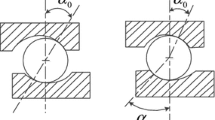Abstract
The dynamic interaction between different machine tool subsystems can be exploited to increase the machine cutting performance. Simplified models are proposed to define useful guidelines that maximize the material removal rate in milling processes in different industrial situations. Two different cases are presented: in the first one, the machine influence on spindle dynamics is considered and optimized. In the second case, the interaction between the control system and the machine tool mechanical structure is analyzed, suggesting control tuning criteria that maximize cutting process stability. The procedure is applied to a real industrial case: a five-axis machine tool with a bi-rotative head. Moreover, requirements for the applicability of the proposed approach are investigated and described by analytical formulas.
Similar content being viewed by others
References
Altintas Y, Weck M (2004) Chatter stability of metal cutting and grinding. CIRP Ann Manuf Technol 53(2):619–642
Mann B, Insperger T, Bayly P, Gabor S (2003) Stability of up-milling and downmilling, part 2: experimental verification. Int J Mach Tools Manuf 43(1):35–40
Bayly PV, Mann BP, Schmitz TL, Peters DA, Gabor S, Insperger T (2002) Effects of radial immersion and cutting direction on chatter instability in end-milling. In: Proceedings of IMECE 2002, ASME
Lee BY, Tarng YS, Ma SC (1995) Modelling of the process damping force in chatter vibration. Int J Mach Tools Manuf 35(7):951–962
Bediaga I, Munoa J, Hernandez J, Lopez de Lecalle LN (2009) An automatic spindle speed selection strategy to obtain stability in high-speed milling. Int J Mach Tools Manuf 49(5):384–394
Neugebauer R, Denkena B, Wegener K (2007) Mechatronic systems for machine tools. CIRP Ann 56(2):657–686
Maj R, Modica F, Bianchi G (2006) Machine tools mechatronic analysis. Proc IME B J Eng Manufact 220(3):345–353
Brecher C, Esser M, Witt S (2009) Interaction of manufacturing process and machine tool. CIRP Ann 58:588–607
Witt S (2007) Integrierte Simulation von Maschine, Werkstuck and spanendem Fertigusprozess. Dissertation, RWTH Aachen University
Altintas Y, Brecher C, Weck M, Witt Y (2005) Virtual machine tool. CIRP Ann 54(2):115–138
Park S, Altintas Y, Movahhedy M (2003) Receptance coupling for end mills. Int J Mach Tools Manuf 43(9):889–896
Schimtz TL, Duncan GS (2005) Three-component receptance coupling substructure analysis for tool point dynamics prediction. J Manuf Sci Eng 127:781–791
Movahhedy MR, Gerami JM (2006) Prediction of spindle dynamics in milling by sub-structure coupling. Int J Mach Tools Manuf 46(3–4):243–251
Duncan GS, Tummond MF, Schmitz TL (2005) An investigation of the dynamic absorber effect in high-speed machining. Int J Mach Tools Manuf 45(4–5):497–507
Yigit AS, Ulsoy AG (2002) Dynamic stiffness evaluation for reconfigurable machine tools including weakly non-linear joint characteristics. Proc IME B J Eng Manufact 216:87
Zatarain M, Lejardi E, Egana F (1998) Modular synthesis of machine tool. CIRP Ann 47(1):333–336
Jen MU, Magrab EB (1996) The dynamic interaction of the cutting process, workpiece, and Lathe's structure in facing. J Manuf Sci Eng 118:348–358
Altintas Y, Cao Y (2005) Virtual design and optimization of machine tool spindles. CIRP Ann 54(1):379–382
Abele E, Altintas Y, Brecher C (2010) Machine tool spindle units. CIRP Ann Manuf Technol 59(2):781–802
Cao H, Holkup H, Altintas Y (2011) A comparative study on the dynamics of high speed spindles with respect to different preload mechanisms. Int J Adv Manuf Technol. doi:10.1007/s00170-011-3356-9
Cao Y, Altintas Y (2007) Modelling of spindle-bearing and machine tool systems for virtual simulation of milling operations. Int J Mach Tools Manuf 47:1342–1350
Kolar P, Sulitka M, Janota M (2010) Simulation of dynamic properties of a spindle and tool system coupled with a machine tool frame. Int J Adv Manuf Technol. doi:10.1007/s00170-010-2917-7
Kolar P, Holkup T (2007) Modeling of a machine tools spindle using a hybrid model. In Proceeding of the 3rd international conference—virtual design and automation, 28–29 June 2007, Poznań, Poland Paper No. S05_06_01_kolar
Brecher C, Witt S (2006) Simulation of machine process interaction with flexible multi-body simulation. In: Proceedings of the 9th CIRP international workshop on modeling of machining operations, Bled, Slovenia, pp 171–178
Kim MS, Chung SC (2005) A systematic approach to design high-performance feed. Int J Mach Tools Manuf 45(12–13):1421–1435
Alter DM, Tsao TC (1994) Stability of turning processes with actively controlled linear motor feed drives. Transaction of the ASME 116:298–307
Korenev BG, Reznikov LM (1993) Dynamic vibration absorbers. Wiley, New York, p 11
Author information
Authors and Affiliations
Corresponding author
Rights and permissions
About this article
Cite this article
Albertelli, P., Cau, N., Bianchi, G. et al. The effects of dynamic interaction between machine tool subsystems on cutting process stability. Int J Adv Manuf Technol 58, 923–932 (2012). https://doi.org/10.1007/s00170-011-3465-5
Received:
Accepted:
Published:
Issue Date:
DOI: https://doi.org/10.1007/s00170-011-3465-5




